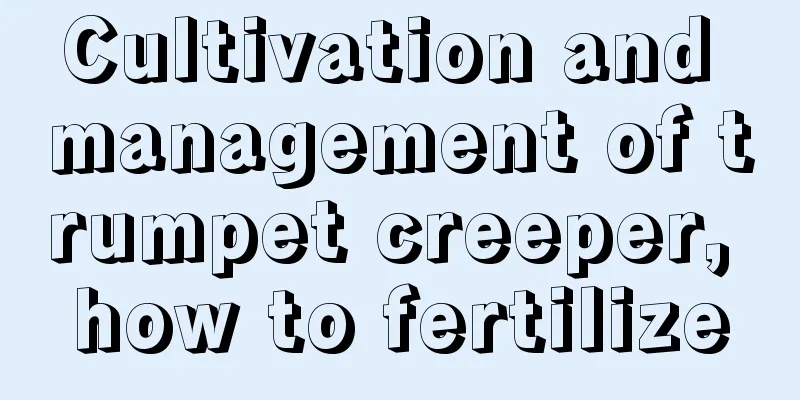Cultivation and management of trumpet creeper, how to fertilize

1. Cultivation MethodsThe cultivation of trumpet creeper is mostly carried out by cutting method, which is specifically carried out in spring and summer. Choose annual cuttings, cut them into 10 to 15 cm lengths, remove the leaves on top to reduce water consumption. After treatment, insert the cuttings into the soil with a row spacing of 15-20 cm and a plant spacing of 5 cm. The depth is about two-thirds of the cuttings. Water thoroughly at a later stage and cover with plastic film in spring. It will take about 20 days for the cuttings to take root. In addition, it can also be done by division and layering. 2. Key points of management1. Watering: It likes a relatively humid environment and the soil cannot be dry for a long time. Therefore, you should water frequently during the growing season to keep the soil moist. But be careful to control the amount and do not let the soil in the pot become waterlogged. 2. Light: It likes the sun. No matter how it is cultivated and cared for, it should be exposed to more sun. It will grow better and bloom better in an environment with sufficient light. Lack of light will cause the branches to grow too tall and affect flowering. 3. Pruning: Pruning should be carried out before budding in early spring every year. The weak and crowded branches should be cut off in time to promote better ventilation and light transmission inside, which is conducive to later growth and flowering. 4. Fertilization: It likes fertilizer. After germination in spring, it needs to be fertilized regularly to supplement the necessary nutrients. The approximate frequency of applying liquid fertilizer is once or twice a month, and phosphorus and potassium fertilizers should be applied before the flowers bloom to promote the differentiation of flower buds. |
<<: Is the White Butterfly Plant suitable for home cultivation?
>>: What crops cannot be treated with isopropylamine?
Recommend
Cultivation methods and precautions of purple root orchid
1. Breeding methods 1. Flower soil: It is afraid ...
Phalaenopsis potted plant maintenance method
Phalaenopsis orchids have large, brightly colored...
Jasmine varieties, what does jasmine look like (pictures of jasmine)
1. Jasmine Varieties There are about 200 differen...
Cultivation methods and precautions of Huanghuai Cassia
1. Fertilizer During cultivation, yellow sophora ...
How to grow Phalaenopsis in pots
1. Breeding environment 1. Soil: Choose loose soi...
The efficacy and function of pitaya
1. Prevent vascular sclerosis Its fruits contain ...
August 8, 2018, I give you 8 kinds of flowers, wishing you have money to spend freely!
Rose Flower language: Waiting for hope and happin...
Top 10 most popular rose varieties, top 10 most valuable rose varieties
1. Hard-flowering varieties 1. Juice Balcony: Thi...
How to keep poinsettia from growing tall
Nowadays, most poinsettias in homes are propagate...
Anthurium cultivation techniques and precautions
Anthurium, with its thick green leaves and emeral...
What to do if the orchid leaves become lighter in color
1. Increase fertilization 1. Reason: The orchid l...
Can tea bran be used as fertilizer?
Tea bran as fertilizer Tea bran can be used as fe...
Disease and Pest Control of Michelia latifolia
Root rot This type of diseased leaves is always a...
How to grow Lycoris radiata? Is Lycoris radiata poisonous?
1. Breeding methods 1. Soil: It refers to the red...
What vegetables are suitable for growing in flower pots? Vegetable varieties suitable for growing in flower pots
Flower pots at home are suitable for planting veg...









